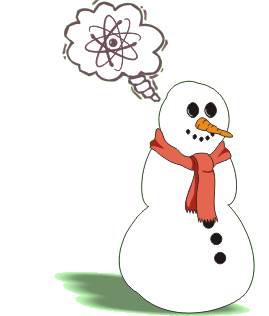Published in the December 2013
issue of the Canadian
Nuclear Society Bulletin, Vol.34, No.4.
Snow Country for Old Men by Jeremy Whitlock  With Meitner was her nephew, Otto Frisch, another refugee Jewish physicist. The two had met up at a friend's home in Kungälv for the Christmas holidays, and now struck out on a bracing walk in the snow - and into the history books.
Frisch on skis, with Aunt Meitner trudging alongside, talked about Hahn's conundrum - more than a conundrum: a constipation of science four years old. Perhaps it was the clarifying embrace of the wintry air, or perhaps the mental unschackling of refugee life, or perhaps the non-linear insight of the gentler gender that had been advancing nuclear science since Marie Curie - somewhere in the Swedish snow the light went on.
Surrounded by frozen liquid drops, Meitner speculated whether the relatively new "Liquid Drop Model" of the nucleus might explain a single neutron inducing oscillations in a uranium nucleus, causing it to break up. Energy would be liberated in the process, and thanks to Einstein they were able to estimate how much: the answer quite literally stopped them in their tracks.
The rest, as they say, is history. Frisch went on to experimentally prove the process, which he coined "fission". Otto Hahn went on to receive a Nobel Prize, downplaying for the rest of his life the role of Lise Meitner - now seen as one of the biggest oversights in Nobel Prize history.
There have been other famous "walks in snow" in history. Pierre Trudeau's legendary midnight stroll in an Ottawa snowstorm in 1984 led to his decision to retire after 15 years as Prime Minister. Hitler without a doubt took a snowy stroll or two around his Führerbunker that final winter of 1945 before deciding to end it all.
Lesser known is the frigid stay of a small group of chemists for the National Research Council, who camped that first winter in 1944 at what would soon become Chalk River Nuclear Laboratories, with orders to design the water treatment plant for the reactors to come. Socked in with few supplies, alone, and freezing, they likely took more than a few strolls in the snow to question their respective decisions to become government scientists.
Stay warm, and Merry Christmas.
With Meitner was her nephew, Otto Frisch, another refugee Jewish physicist. The two had met up at a friend's home in Kungälv for the Christmas holidays, and now struck out on a bracing walk in the snow - and into the history books.
Frisch on skis, with Aunt Meitner trudging alongside, talked about Hahn's conundrum - more than a conundrum: a constipation of science four years old. Perhaps it was the clarifying embrace of the wintry air, or perhaps the mental unschackling of refugee life, or perhaps the non-linear insight of the gentler gender that had been advancing nuclear science since Marie Curie - somewhere in the Swedish snow the light went on.
Surrounded by frozen liquid drops, Meitner speculated whether the relatively new "Liquid Drop Model" of the nucleus might explain a single neutron inducing oscillations in a uranium nucleus, causing it to break up. Energy would be liberated in the process, and thanks to Einstein they were able to estimate how much: the answer quite literally stopped them in their tracks.
The rest, as they say, is history. Frisch went on to experimentally prove the process, which he coined "fission". Otto Hahn went on to receive a Nobel Prize, downplaying for the rest of his life the role of Lise Meitner - now seen as one of the biggest oversights in Nobel Prize history.
There have been other famous "walks in snow" in history. Pierre Trudeau's legendary midnight stroll in an Ottawa snowstorm in 1984 led to his decision to retire after 15 years as Prime Minister. Hitler without a doubt took a snowy stroll or two around his Führerbunker that final winter of 1945 before deciding to end it all.
Lesser known is the frigid stay of a small group of chemists for the National Research Council, who camped that first winter in 1944 at what would soon become Chalk River Nuclear Laboratories, with orders to design the water treatment plant for the reactors to come. Socked in with few supplies, alone, and freezing, they likely took more than a few strolls in the snow to question their respective decisions to become government scientists.
Stay warm, and Merry Christmas.
| ||||
|
Discussion welcome. ©2013 Jeremy Whitlock
| ||||
|
The Canadian Nuclear FAQ] |
